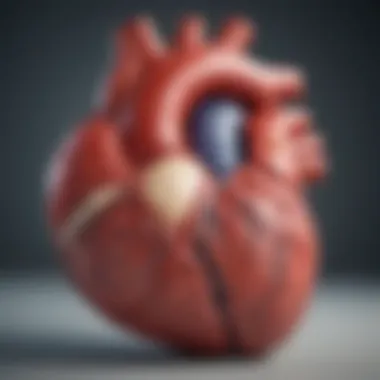Understanding Dilated and Hypertrophic Cardiomyopathy


Intro
Dilated cardiomyopathy (DCM) and hypertrophic cardiomyopathy (HCM) represent significant challenges in the realm of heart disease. Their distinct pathophysiological mechanisms and clinical presentations require a nuanced understanding among healthcare professionals and researchers alike. As heart muscle disorders, both conditions affect the ability of the heart to function efficiently, leading to various symptoms and complications. The exploration of these conditions involves delving into their etiology, manifestations, diagnostic criteria, and treatment options. Additionally, genetic predispositions and environmental factors play crucial roles in the development and progression of both DCM and HCM.
Understanding the complexities surrounding these cardiomyopathies is essential for developing effective management strategies. This article aims to elucidate key concepts and foster informed discussions within the medical community.
Recent Advances
Recent research has yielded significant insight into DCM and HCM, enhancing our comprehension of these cardiac disorders.
Latest Discoveries
Recent studies have focused on identifying specific genetic mutations associated with DCM and HCM. For instance, mutations in the TTN gene have been linked to DCM, while MYH7 mutations are often observed in HCM cases. These realizations are pivotal as they guide genetic counseling and risk assessment in affected families. Furthermore, increased recognition of the influence of environmental factors, such as obesity and hypertension, highlights the multifactorial nature of these diseases.
Understanding the differences in disease progression between individuals has led to personalized approaches in treatment. This includes tailored pharmacological interventions that consider the unique genetic and phenotypic characteristics of patients.
Technological Innovations
Advancements in cardiology technology also play a role in the management of these conditions. Non-invasive imaging techniques, such as magnetic resonance imaging (MRI) and echocardiography, are pivotal tools for accurate diagnosis. These technologies can assess ventricular function and structure, providing vital information for making informed clinical decisions.
Furthermore, wearable technologies are being developed to monitor patients continuously, offering real-time data on heart function. This is particularly useful for managing symptoms and preventing complications in individuals with DCM and HCM.
"Understanding genetic underpinnings equips clinicians with valuable tools for diagnosis and targeted therapies."
Methodology
To provide a comprehensive overview of dilated and hypertrophic cardiomyopathy, it is crucial to examine the methodologies employed in recent research.
Research Design
Most studies on DCM and HCM utilize a combination of retrospective and prospective designs. Longitudinal studies allow researchers to track disease progression and treatment outcomes over time. Cross-sectional studies often explore the prevalence of genetic mutations in various populations.
Data Collection Techniques
Data collection methods commonly involve:
- Genetic Testing: To identify mutations in individuals diagnosed with cardiomyopathy.
- Clinical Assessments: To gauge symptom severity and functional capacity.
- Imaging Studies: To evaluate heart structure and performance.
These methods contribute to a broader understanding of the cardiomyopathies, enabling researchers to identify patterns that may inform future treatment pathways.
By analyzing advancements in both scientific research and technology, we can enhance our knowledge of dilated and hypertrophic cardiomyopathy. This foundation will facilitate the development of comprehensive strategies for diagnosis, treatment, and patient management.
Prologue to Cardiomyopathy
Cardiomyopathy encompasses a range of diseases affecting the heart muscle. Understanding these conditions is essential for healthcare professionals and researchers alike. By examining the various types, such as dilated and hypertrophic cardiomyopathy, one uncovers the mechanisms and impacts these diseases have on cardiac function.
In this article, we aim to highlight the significance of cardiomyopathy. It is vital for recognizing symptoms, initiating early treatment, and improving patient outcomes. A thorough grasp of this subject also aids researchers in advancing cardiovascular medicine.
Definition of Cardiomyopathy
Cardiomyopathy refers to a group of disorders that affect the heart muscle, leading to compromised cardiac function. These diseases can result in the heart becoming enlarged, thickened, or stiffened, ultimately impairing its ability to pump blood effectively. There are several forms of cardiomyopathy, with dilated and hypertrophic being the most common. Understanding these definitions is crucial for distinguishing between the various types and their unique characteristics.
Overview of Heart Muscle Diseases
Heart muscle diseases can manifest in various ways, each with distinct presentations, causes, and treatment options. The primary types include:
- Dilated Cardiomyopathy: Characterized by ventricular enlargement and weakened contractions.
- Hypertrophic Cardiomyopathy: Involves thickening of the heart muscle, which can lead to outflow obstruction.
- Restrictive Cardiomyopathy: The heart becomes stiff, restricting its ability to fill with blood.
Each type presents varying symptoms that can affect one’s quality of life. Challenging symptoms might include fatigue, breathlessness, and arrhythmias. It is crucial to understand these heart muscle diseases to manage them effectively.
Cardiomyopathy is not merely a single condition but a spectrum that requires comprehensive understanding and thoughtful approach to treatment.
Dilated Cardiomyopathy


Dilated cardiomyopathy (DCM) represents a significant form of heart disease marked by the dilation of the heart chambers and impaired contraction. Recognizing DCM is crucial as it affects heart function, leading to heart failure and other serious complications. Understanding its characteristics helps clinicians provide better care.
Pathophysiology of Dilated Cardiomyopathy
The pathophysiology of DCM revolves around the heart's inability to pump efficiently. The left ventricle enlarges and weakens, leading to a reduction in its contractile abilities. This condition invites a sequence of compensatory mechanisms, such as increased heart rate and neurohormonal activation. Over time, these compensations can further deteriorate heart function. The mechanisms involve alterations at the cellular level, including changes in myocyte structure and function.
Etiology of Dilated Cardiomyopathy
Inherited Factors
Inherited factors play a considerable role in the development of DCM. Familial cases often arise from genetic mutations affecting the sarcomere, the basic contractile unit of muscle fibers. One notable characteristic of inherited DCM is its potential for familial clustering. Genetic screening can provide insight into inheritance patterns. While some show clear inheritance, others may appear sporadic.
Acquired Causes
Acquired causes of DCM include a variety of conditions. Sometimes, it results from prolonged alcohol use, viral infections, or exposure to certain toxins. The key feature of acquired causes is their external nature, impacting heart muscle health. Unlike inherited factors, these can often be reversible. Identification of these causes facilitates targeted interventions.
Autoimmune Influences
Autoimmune influences also contribute to DCM's etiology. In some cases, the body’s immune system mistakenly attacks heart tissue, resulting in inflammation and damage. Autoimmune conditions, such as lupus or rheumatoid arthritis, may align with this type of DCM. The unique attribute of autoimmune factors is their impact on multiple organs and systems. This aspect makes management complex, as it requires multidisciplinary approaches.
Clinical Manifestations of Dilated Cardiomyopathy
Symptoms and Signs
Symptoms of DCM can be subtle initially. Patients may experience fatigue, shortness of breath, and swelling in their legs. A key characteristic is the variability in symptoms among patients. Some may be asymptomatic for periods, while others can present with severe symptoms. Recognizing these signs early can lead to timely interventions, improving prognosis.
Progression of the Disease
The progression of DCM can vary widely among individuals. Without treatment, it typically worsens over time, often leading to heart failure. Common progression features include increased heart chamber size and functional decline. Regular monitoring is essential to manage the disease trajectory effectively. Patients should be educated on the importance of follow-up visits and adherence to treatment plans.
Diagnostic Approaches for Dilated Cardiomyopathy
Imaging Techniques
Imaging techniques form a cornerstone in diagnosing DCM. Echocardiograms are commonly used to visualize heart structure and function. A key advantage of these techniques is their non-invasive nature, allowing clinicians to obtain essential information without discomfort to the patient. However, they require skilled interpretation to ensure accurate diagnosis.
Laboratory Tests
Laboratory tests support the diagnostic process by providing biochemical data. Blood tests can indicate elevated heart enzymes, suggesting heart damage. Additionally, other markers can assess inflammation or other underlying conditions. The unique feature of laboratory tests is their ability to identify systemic factors influencing cardiac health.
Electrophysiological Studies
Electrophysiological studies explore the heart's electrical system. These studies can identify arrhythmias often associated with DCM. A key characteristic is the potential to tailor therapies based on findings. While these studies can be invasive, they provide crucial insights into the functioning of the heart and its electrical properties, guiding management decisions.
Treatment Options for Dilated Cardiomyopathy
Pharmacological Interventions
Pharmacological interventions are fundamental in managing DCM. Medications, such as beta-blockers and ACE inhibitors, help improve heart function and manage symptoms. A significant advantage of these treatments is their ability to improve quality of life and slow disease progression. However, careful dosing and monitoring are essential to avoid potential side effects.
Device Therapy
Device therapy may be recommended for patients with advanced symptoms or arrhythmias. Implantable cardioverter-defibrillators (ICDs) and cardiac resynchronization therapy (CRT) are common interventions. These devices not only help stabilize heart rhythm but also enhance cardiac output. While beneficial, they require surgical implantation and thorough patient education on usage.
Heart Transplantation
In severe cases, heart transplantation represents a last-resort option. It offers a chance for long-term survival and improved quality of life. However, the process involves rigorous selection criteria and lifelong follow-up care post-transplant. While transplantation has a unique advantage of restoring heart function, the challenges surrounding donor availability and rejection remain significant considerations.
Hypertrophic Cardiomyopathy
Hypertrophic Cardiomyopathy (HCM) is a significant topic in the study of heart muscle diseases. It is essential to understand HCM as it has unique characteristics that differentiate it from other cardiomyopathies, such as dilated cardiomyopathy. HCM can lead to severe complications if not recognized and managed properly, impacting not only the patient's quality of life but also their longevity. Exploring HCM allows for better appreciation of its complexities, which aids in diagnosing and treating patients effectively.
Pathophysiology of Hypertrophic Cardiomyopathy
HCM is primarily characterized by an abnormal thickening of the heart muscle, particularly the interventricular septum. This thickening can interfere with the heart's ability to pump blood effectively. The condition may also cause obstruction in the outflow tract between the left ventricle and aorta, leading to dynamic left ventricular outflow obstruction. The pathophysiology often includes disorganized arrhythmic heart muscle fibers, which can increase the risk of sudden cardiac events.


Etiology of Hypertrophic Cardiomyopathy
Genetic Mutations
Genetic mutations play a crucial role in the development of Hypertrophic Cardiomyopathy. These mutations commonly affect genes responsible for cardiac muscle contraction, including MYBPC3 and MYH7. The identification of these mutations is a beneficial choice for this article as it highlights the hereditary nature of HCM, allowing for early diagnosis and potential interventions in families at risk. The characteristic of genetic mutations provides substantial evidence for the necessity of screening relatives of affected individuals.
Environmental Factors
Environmental factors can also contribute to the progression of HCM. Conditions such as high blood pressure can exacerbate the symptoms. The consideration of environmental factors in this article can give a broader context to the disease. Recognizing these influences can guide lifestyle changes that may alleviate symptom severity. However, the association of environmental factors may vary significantly between individuals, complicating their management.
Clinical Manifestations of Hypertrophic Cardiomyopathy
Symptoms and Signs
Symptoms of HCM may range from mild to severe, including shortness of breath, chest pain, and palpitations. In many cases, individuals can remain asymptomatic, making diagnosis challenging. The significance of understanding these symptoms in this article lies in the potential for early detection and treatment. The unique feature of symptoms is that they often appear during physical exertion, indicating underlying heart issues that may be missed in routine evaluations.
Complications and Risks
Complications arising from HCM can be serious. These include heart failure, atrial fibrillation, and sudden cardiac death. The recognition of these risks within this article is vital as it underscores the urgent need for monitoring individuals diagnosed with HCM. The unique feature of these complications is their potential to develop unexpectedly and lead to fatal outcomes.
Diagnostic Approaches for Hypertrophic Cardiomyopathy
Imaging Modalities
Imaging modalities, such as echocardiograms, are essential in diagnosing HCM. These tests allow for visualization of the heart’s structure and can identify thickness in the heart muscle. The inclusion of imaging modalities as a critical tool in this article emphasizes their role in timely diagnosis and treatment decisions. Their unique feature lies in their non-invasive nature, enabling repeated assessments without substantial risk to the patient.
Genetic Testing
Genetic testing offers insight into the hereditary patterns associated with HCM. Testing can confirm a diagnosis and assist in family planning decisions. Highlighting genetic testing in this article is important as it guides discussions about the risks to relatives. However, the results can sometimes lead to anxiety among family members about potential risks.
Longitudinal Studies
Longitudinal studies are pivotal in understanding the progression of HCM. These studies track patients over time, providing insight into how the disease may evolve. The emphasis on longitudinal studies in this article can help researchers and clinicians develop better management strategies. The unique feature of these studies is their ability to provide long-term data, which is invaluable for creating personalized treatment plans.
Treatment Options for Hypertrophic Cardiomyopathy
Medications
Medications such as beta-blockers and calcium channel blockers can help control symptoms of HCM. The use of medications in this article is significant as it addresses non-invasive treatment options that can improve patients' quality of life. The unique aspect of medications is their potential to help manage the disease effectively without the need for immediate surgical intervention.
Surgical Interventions
In certain cases, surgical procedures may be required to relieve obstruction caused by thickened heart muscle. Surgical interventions like septal myectomy can improve symptoms significantly. This article illustrates the importance of surgical options for patients who do not respond to medication, pointing to the need for a multifaceted management plan. Nonetheless, surgery carries its risks and may not be appropriate for all patients.
Patient Education
Educating patients about HCM is crucial for effective management. Knowledge about the disease, treatment options, and lifestyle modifications can empower patients to take an active role in their health. Highlighting patient education in this article emphasizes its role in improving adherence to treatment and lifestyle changes. The unique feature is that informed patients tend to experience better outcomes, making education a valuable element in care strategies.
Understanding Hypertrophic Cardiomyopathy through comprehensive education and timely interventions can lead to improved management of this complex condition.
This exploration of Hypertrophic Cardiomyopathy underscores the necessity for ongoing research and awareness in both medical communities and among patients.
Comparative Analysis: vs HCM
The comparative analysis of dilated cardiomyopathy (DCM) and hypertrophic cardiomyopathy (HCM) is essential for understanding how these two significant heart disorders affect individuals in different ways. A thorough examination of their similarities and differences can illuminate various aspects of their diagnosis and treatment. It aids healthcare professionals, researchers, and educators in developing tailored therapeutic strategies and improving patient care. Assessing both conditions elucidates the diverse effects these cardiomyopathies have on heart function, morbidity, and overall quality of life.
Similarities in Clinical Presentation
DCM and HCM share several overlapping clinical symptoms, making accurate diagnosis crucial. Both conditions can lead to heart failure and various degrees of cardiac dysfunction over time. Common symptoms include:
- Shortness of breath: This is prevalent in both DCM and HCM, especially during exertion.
- Fatigue: Patients often experience increased fatigue, limiting daily activities.
- Palpitations: Irregular heartbeats can be noted in both scenarios, complicating the clinical picture.
- Chest pain: Although it can arise from different mechanisms in DCM and HCM, chest discomfort is frequently reported.
- Syncope: Loss of consciousness can occur, especially under stress or physical exertion.
These overlapping symptoms necessitate a careful clinical evaluation and differential diagnosis. It highlights the importance of thorough patient history and physical examination, as each condition's management may vary significantly despite similar presentations.


Differences in Pathophysiological Mechanisms
The pathophysiological mechanisms underlying DCM and HCM differ markedly, influencing their clinical management and outcomes.
In dilated cardiomyopathy, the heart's chamber enlarges, leading to a weakened pumping capability. This condition often results from a variety of factors, including genetic mutations, infections, and alcohol abuse. The electric conduction system can also be affected, potentially leading to arrhythmias. Symptoms primarily stem from reduced cardiac output.
In contrast, hypertrophic cardiomyopathy is characterized by a thickening of the heart muscle, particularly the ventricles. This abnormal growth can obstruct blood flow and cause diastolic dysfunction, whereby the heart has difficulty filling. HCM is often a genetic condition resulting from mutations in sarcomeric proteins. The risk of sudden cardiac death is notably higher in HCM due to potential arrhythmias triggered by the structural anomalies.
Understanding these differences in pathophysiology aids in developing specific therapeutic interventions. For instance, while medications for DCM often focus on managing heart failure symptoms, treatment for HCM may involve beta-blockers or surgical options to alleviate obstruction.
Genetic Considerations in Cardiomyopathy
Genetic factors play a significant role in the understanding and management of cardiomyopathies, particularly in dilated cardiomyopathy (DCM) and hypertrophic cardiomyopathy (HCM). The study of genetic considerations in these conditions is critical due to its implications for diagnosis, treatment, and familial risk assessment. Knowing the genetic basis of these diseases allows for precision in management strategies. It also enhances the ability to identify individuals at risk within families and leads to better healthcare outcomes.
Genetic Testing and Counseling
Genetic testing emerges as a vital tool in the assessment of cardiomyopathy. This testing evaluates specific gene mutations associated with both DCM and HCM. Identifying these mutations can confirm a diagnosis, especially when clinical presentations are ambiguous. Furthermore, the results can guide clinical decisions regarding the management of the condition.
Understanding genetic implications helps in tailored treatment plans. For example, patients with identified mutations may benefit from targeted therapies or require more vigilant monitoring for heart failure or arrhythmias.
Counseling is essential following genetic testing. A genetic counselor provides valuable insight into test results and their significance. They discuss potential risks for family members, the likelihood of disease manifestation, and implications for reproductive choices. Clear communication and support through education empower patients and families.
Familial Patterns of Disease
Familial patterns in cardiomyopathy showcase the hereditary nature of these conditions. DCM and HCM often exhibit autosomal dominant inheritance, which means one copy of the altered gene in each cell is sufficient to cause the disorder. This inheritance pattern raises critical questions for families.
Identifying affected relatives can prompt earlier diagnosis and management. Families with a known history of cardiomyopathy may have additional tests to uncover asymptomatic carriers.
Some key points regarding familial patterns include:
- Penetrance: Not all individuals carrying a mutation express the disease. Familial cardiomyopathy can display different severity levels from one generation to the next.
- Genetic Variability: Different genes can cause similar symptoms, complicating the diagnosis process.
- Risk Assessment: Close monitoring can aid in early intervention to prevent severe complications.
Research Advances and Future Directions
Research advances in the realm of cardiomyopathy, specifically dilated cardiomyopathy (DCM) and hypertrophic cardiomyopathy (HCM), play a crucial role in shaping both diagnostics and therapeutic strategies. As our understanding of these conditions evolves, so too does our capacity to improve patient outcomes and tailor treatment regimens to individual needs. This section will explore innovations in diagnostic technology and emerging therapies, highlighting how these advances can significantly impact future research and clinical practice.
Innovations in Diagnostic Technology
Advancements in diagnostic technology have revolutionized the identification and management of cardiomyopathies. With the integration of more sophisticated imaging modalities, the precision in diagnosing DCM and HCM has notably increased. Techniques such as cardiac magnetic resonance imaging (MRI) provide a non-invasive method to assess heart structure and function with high detail. These imaging advancements allow for better differentiation between types of cardiomyopathy and other heart diseases, paving the way for improved management strategies.
Additionally, biomarkers have emerged as invaluable tools in the diagnostic arsenal. The identification of specific proteins and enzymes in blood can correlate with the severity of cardiac dysfunction. For instance, elevated levels of natriuretic peptides can indicate heart stress and often serve as a marker for cardiovascular diseases, including both DCM and HCM.
"Refining diagnostic processes not only leads to early intervention but also enhances the understanding of the disease's natural history."
Molecular genetic testing is also gaining traction as a key component in the diagnostic pathway. Identifying mutations in genes associated with hypertrophic cardiomyopathy streamlines the diagnosis and allows for family screening, which can be critical in preventing life-threatening complications. This level of precision in diagnostics is fundamental to ensuring that patients receive the most appropriate and effective care.
Emerging Therapies in Treatment
The treatment landscape for both DCM and HCM is rapidly evolving. New pharmacological interventions, including novel beta-blockers and angiotensin receptor-neprilysin inhibitors, show promise in managing symptoms and improving overall heart function. These medications target specific pathways involved in cardiac stress and remodeling, providing an innovative approach to treatment that could yield better patient outcomes.
A significant area of progress lies in device therapy. Innovations like implantable cardioverter-defibrillators (ICDs) not only prevent fatal arrhythmias but also monitor cardiac function in real-time. The integration of telehealth technology allows continuous tracking of a patient’s heart health, ensuring timely interventions when abnormalities are detected.
Moreover, gene therapy represents a frontier in treating cardiomyopathies, particularly HCM. This approach seeks to deliver corrective genes to cardiac cells, potentially reversing pathological changes. Clinical trials are ongoing to assess the safety and efficacy of such strategies, which could redefine treatment protocols in the coming years.
In summary, the field of cardiomyopathy is at a pivotal juncture. Innovations in diagnostic technology and emerging therapies hold the promise of better detection, improved therapies, and personalized medicine. Continuing to invest in research will be essential to unlock the full potential of these advancements and address the ongoing challenges faced by patients and healthcare providers alike.
Ending
The exploration of dilated cardiomyopathy (DCM) and hypertrophic cardiomyopathy (HCM) highlights vital aspects of heart muscle diseases. Their distinct pathophysiological processes, varied etiologies, and unique manifestations emphasize the complexity of cardiovascular health. This article provides valuable insights into not just the medical characteristics but also the implications for diagnosis and treatment. By understanding both conditions better, we can facilitate better patient care and therapeutic approaches.
Summation of Key Findings
In this article, we have discussed several critical factors regarding DCM and HCM:
- Pathophysiology: DCM is characterized by ventricular dilation, impacting systolic function, while HCM presents with left ventricular hypertrophy, affecting diastolic function.
- Etiologies: DCM can stem from genetic, viral, and environmental influences, while HCM is largely due to genetic mutations.
- Symptoms: Common symptoms include dyspnea for both conditions, but they may present differently in each case.
- Diagnosis: Advanced imaging and genetic testing are crucial in distinguishing between DCM and HCM accurately.
- Treatment: The management strategies vary significantly, from heart transplantation in severe cases of DCM to surgical options for HCM.
Implications for Future Research
The landscape of cardiomyopathy research is evolving, with many avenues for future exploration:
- Genetic Studies: Investigating the precise genetic mutations that lead to HCM can refine diagnostic criteria and inform treatment strategies.
- Longitudinal Studies: Following patients over extended periods can provide insights into disease progression and treatment efficacy.
- Innovative Therapies: Exploring potential new therapies, including gene therapy or targeted medications, could enhance treatment outcomes.
- Patient Education: Improved strategies for educating patients regarding their conditions could lead to better self-management and compliance with treatment regimes.
Understanding these factors not only holds significance for medical professionals but also for patients and their families. Enhanced research in these areas will support advancements in clinical practices and ultimately improve patient outcomes.















